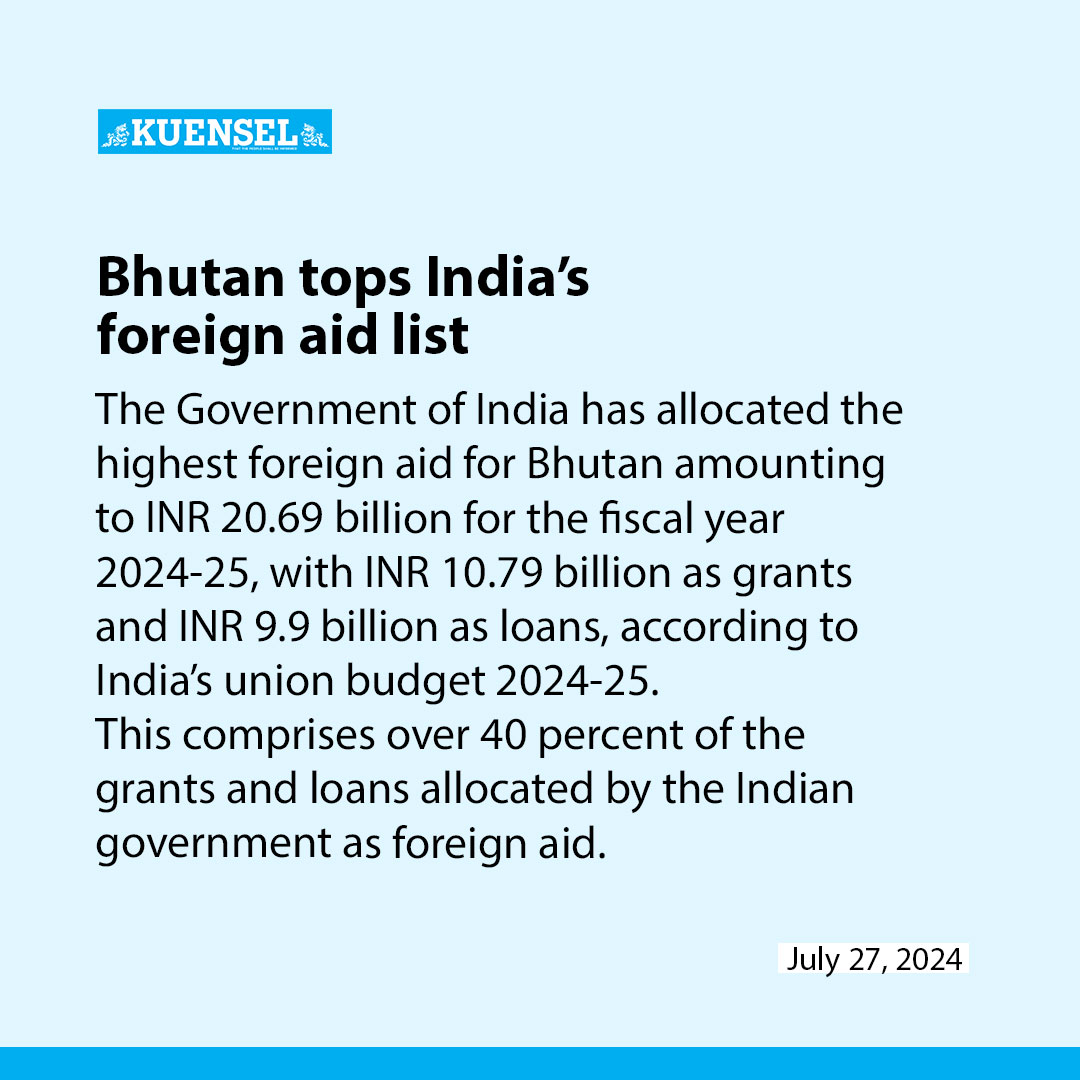INR 20.69 billion allocated to Bhutan for fiscal year 2024-25
Thukten Zangpo
The Government of India has allocated the highest foreign aid for Bhutan amounting to INR 20.69 billion for the fiscal year 2024-25, with INR 10.79 billion as grants and INR 9.9 billion as loans, according to India’s union budget 2024-25.
This comprises over 40 percent of the grants and loans allocated by the Indian government as foreign aid.
For the fiscal year 2024-25, the Indian government’s aid (both grants and loans) was projected at INR 48.84 billion.
Nepal is allocated the second highest foreign aid with INR 7 billion as grants, followed by INR 4 billion for Maldives, INR 3.7 billion for Mauritius, INR 2.5 billion for Myanmar, INR 2.45 billion for Sri Lanka, and INR 2 billion for Afghanistan, among others.
In the fiscal year 2023-24, the Indian government revised the assistance to Bhutan to INR 23.99 billion. It comprises INR 7.85 billion as grants and INR 16.14 billion as loans.
At the same time, INR 24.67 billion was provided in the fiscal year 2022-23, INR 17.63 billion as grants and INR 7.04 billion as loans.
In the 12th Plan, the Indian government provided a grant of INR 45 billion to Bhutan.
In March this year, the Prime Minister of India, Narendra Modi committed a grant of INR 85 billion to support the 13th Plan, and INR 15 billion for the Economic Stimulus Programme.
During the launch of 13th Plan, India’s Ambassador to Bhutan, Sudhakar Dalela said that the 13th Plan document captures the government’s development agenda across sectors such as governance, health, education, skill development, digitisation, energy, economy, infrastructure and private enterprise.
“This ambitious plan aims to transform the economy towards a high-income growth trajectory,” he said.
Ambassador Sudhakar Dalela also said that Bhutan and India enjoy unique type of friendship and cooperation. “Ours is an extraordinary partnership ranging from diverse sectors from education to economy, health, hydropower, from sports to space, and from data to technology.”
He added that the expanding partnership of both the countries is a clear testimony to the vision and wisdom of Their Majesties in Bhutan and successive leadership in India and Bhutan who have nurtured the unique ties of friendship and cooperation over the years.
“Through successive five-year plans, our development cooperation has resulted in completion of several flagship infrastructure projects benefiting the Bhutanese people and contributing to Bhutan’s overall economic development and advancing India-Bhutan friendship,” Sudhakar Dalela said.
He added that India will continue to remain a steadfast and a reliable development partner of Bhutan as going forward.
Of the total allocated budget for the fiscal year 2024-25, the expenditure is estimated at Nu 89.15 billion – Nu 50.81 billion in recurrent and Nu 38.34 billion in capital expenditure. Recurrent and capital expenditure constituted 57 percent and 43 percent of the total expenditure respectively.
With the total resources available at Nu 73.18 billion and total budget outlay of Nu 89.15 billion, it leaves a fiscal deficit of Nu 15.97 billion, equivalent to 5.2 percent of GDP.
For the fiscal year 2024-25, the government’s budget report estimated the external grant at Nu 16.52 billion, which comprises project-tied and programme grants from development partners.
The major portion of the external grant is from the Indian government consisting of Nu 10.54 billion under project-tied assistance and Nu 1.67 billion as programme grant.
Bhutan will receive Nu 818.65 million grant from the Asian Development Bank, Nu 636.92 million from the European Union, Nu 508 million from the World Bank, and Nu 409.93 million from World Health Organisation.
In the 13th Plan, with the total budget outlay of Nu 512.28 billion, the fiscal deficit is estimated at Nu 55.94 billion, equivalent to 2.97 percent of gross domestic product.
The total grant for the plan period is estimated at Nu 125 billion, constituting 27 percent of total resources, which will finance at least 51 percent of the capital expenditure.
A large chunk of the external grant, Nu 85 billion, comes from India and the remaining Nu 40 billion from European Union, Japan, UN agencies and other development partners.


